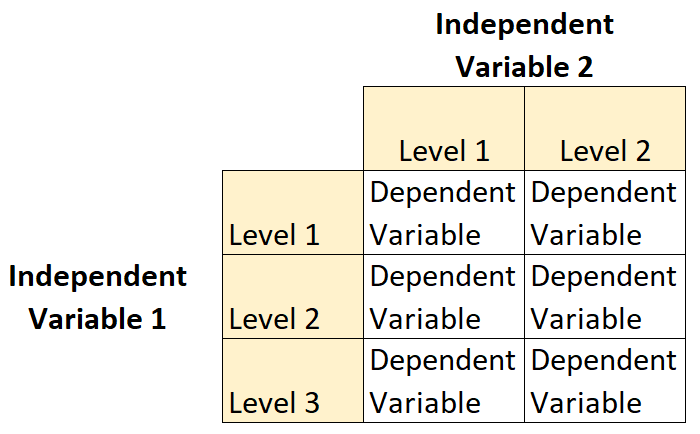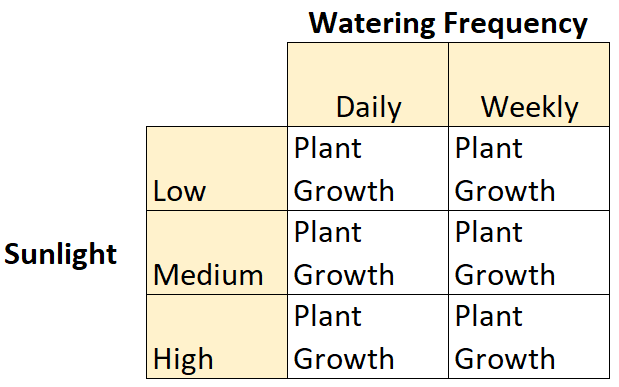A 2×3 factorial design is a type of experimental design that allows researchers to understand the effects of two independent variables on a single dependent variable.
In this type of design, one independent variable has two levels and the other independent variable has three levels.

For example, suppose a botanist wants to understand the effects of sunlight (low vs. medium vs. high) and watering frequency (daily vs. weekly) on the growth of a certain species of plant.

This is an example of a 2×3 factorial design because there are two independent variables, one having two levels and the other having three levels:
- Independent variable #1: Sunlight
- Levels: Low, Medium, High
- Independent variable #2: Watering Frequency
And there is one dependent variable: Plant growth.
The Purpose of a 2×3 Factorial Design
A 2×3 factorial design allows you to analyze the following effects:
Main Effects: These are the effects that just one independent variable has on the dependent variable.
For example, in our previous scenario we could analyze the following main effects:
- Main effect of sunlight on plant growth.
- Mean growth of all plants that received low sunlight.
- Mean growth of all plants that received medium sunlight.
- Mean growth of all plants that received high sunlight.
- Main effect of watering frequency on plant growth.
- Mean growth of all plants that were watered daily.
- Mean growth of all plants that were watered weekly.
Interaction Effects: These occur when the effect that one independent variable has on the dependent variable depends on the level of the other independent variable.
For example, in our previous scenario we could analyze the following interaction effects:
- Does the effect of sunlight on plant growth depend on watering frequency?
- Does the effect of watering frequency on plant growth depend on the amount of sunlight?
How to Analyze a 2×3 Factorial Design
We can perform a two-way ANOVA to formally test whether or not the independent variables have a statistically significant relationship with the dependent variable.
For example, the following code shows how to perform a two-way ANOVA for our hypothetical plant scenario in R:
#make this example reproducibleset.seed(0)#create datadf <- data.frame(sunlight = rep(c('Low', 'Medium', 'High'), each = 15, times = 2), water = rep(c('Daily', 'Weekly'), each = 45, times = 2), growth = c(rnorm(15, 9, 2), rnorm(15, 10, 3), rnorm(15, 13, 2), rnorm(15, 8, 3), rnorm(15, 10, 4), rnorm(15, 12, 3)))#fit the two-way ANOVA modelmodel <- aov(growth ~ sunlight * water, data = df)#view the model outputsummary(model) Df Sum Sq Mean Sq F value Pr(>F) sunlight 2 602.3 301.15 50.811 <2e-16 ***water 1 39.6 39.62 6.685 0.0105 * sunlight:water 2 15.1 7.56 1.275 0.2819 Residuals 174 1031.3 5.93 ---Signif. codes: 0 '***' 0.001 '**' 0.01 '*' 0.05 '.' 0.1 ' ' 1Here’s how to interpret the output of the ANOVA:
- The p-value associated with sunlight is <2e-16.Since this is less than .05, this means sunlight exposure has a statistically significant effect on plant growth.
- The p-value associated with water is.0105. Since this is less than .05, this means watering frequency also has a statistically significant effect on plant growth.
- The p-value for the interaction between sunlight and water is.2819. Since this is not less than .05, this means there is no interaction effect between sunlight and water.
Additional Resources
The following tutorials provide additional information on experimental design and analysis:
A Complete Guide: The 2×2 Factorial Design
What Are Levels of an Independent Variable?
Independent vs. Dependent Variables
What is a Factorial ANOVA?
FAQs
A 2×3 factorial design is a type of experimental design that allows researchers to understand the effects of two independent variables on a single dependent variable. In this type of design, one independent variable has two levels and the other independent variable has three levels.
What is a 3 2 factorial design model? ›
study in which there are 2 factors with 3 levels is called a 3 2 factorial design. In this design 2 factors were evaluated each at 3 levels and experimental trials were performed at all 9 possible combinations as reflected in Table 1.
How many conditions would you have if you have a 2x3 factorial experimental design? ›
It's a 2x3 design, so it should have 6 conditions. As you can see there are now 6 cells to measure the DV.
What is a 2 2 factorial design? ›
A 2 X 2 factorial design requires interpretation of three effects – a main effect for the first IV, a main effect for the second IV, and the interaction of the two IVs. A main effect signifies that there is an effect of that IV on the DV regardless of the levels of the other IV.
What is a 2 3 factorial design with three independent variables? ›
A 2 x 3 factorial design has three independent variables. An interaction indicates that the effect of one independent variable depends on the particular level of another independent variable. A 2 x 3 x 4 study would yield information about 3 two factor interactions.
How many independent variables are there in a 2x3 factorial design? ›
2 x 2, 3 x 3, and 2 x 3 designs all have two numbers in the notation and therefore all have two independent variables. The numerical value of each of the numbers represents the number of levels of each independent variable.
How to do factorial math? ›
In short, a factorial is a function that multiplies a number by every number below it till 1. For example, the factorial of 3 represents the multiplication of numbers 3, 2, 1, i.e. 3! = 3 × 2 × 1 and is equal to 6.
What is factorial design with an example? ›
In factorial designs, a factor is a major independent variable. In this example we have two factors: time in instruction and setting. A level is a subdivision of a factor. In this example, time in instruction has two levels and setting has two levels.
How to find main effects in factorial design? ›
The calculation of the main effect A was described in the Module 5 Factorial Design of Experiments. The main effect of A is calculated by subtracting the average responses at the low-level from the average responses at the high-level.
How many interactions are there in a 2x3 factorial design? ›
In a 2x3 factorial design, there are six interactions, which are combinations of each level of one factor with each level of the other factor.
Factorial experiments are the experiments that investigate the effects of two or more factors or input parameters on the output response of a process.
What is the main advantage of factorial designs? ›
Factorial designs are a powerful tool for industrial engineers who want to optimize processes, products, or systems by testing multiple factors and their interactions at once. They can help you save time, money, and resources by reducing the number of experiments needed to obtain reliable results.
How many main effects are there in a 2 2 2 factorial design? ›
If you had a 2x2x2 design, you would measure three main effects, one for each IV.
What is an example of a 2 by 2 factorial design? ›
A 2x2 factorial design example would be the following: A researcher wants to evaluate two groups, 10-year-old boys and 10-year-old girls, and how the effects of taking a summer enrichment course or not affects math test scores. In this case, there are two factors, the boys and girls.
Will a 2x2 factorial design have main effects? ›
What's involved in a 2x2 factorial design ? Main effects involve the comparison of marginal means. Simple effects involve the comparison of cell means. Interactions involve the comparison of simple effects.
What is a 3x2 factorial ANOVA? ›
By refering to our design as “3x2” indicates that we have two independent variables. The first has 3 levels and the second has 2 levels. The within-subjects name indicates that each participant will receive all levels of all IVs (and have a dependent variable score associated with each administration).
What does a 2x2x2 factorial design mean? ›
an experimental design in which there are two independent variables each having two levels. When this design is depicted as a matrix, two rows represent one of the independent variables and two columns represent the other independent variable. Also called two-by-two design; two-way factorial design.
What is a 2x4 factorial design? ›
A factorial design is an experiment with two or more factors (independent variables). 2 x 4 design means two independent variables, one with 2 levels and one with 4 levels. "condition" or "groups" is calculated by multiplying the levels, so a 2x4 design has 8 different conditions.
What is in a three way factorial design? ›
The Three-Way Factorial design has three grouping factors (independent variables A,B and C) and one observed value (dependent variable). where A, B, and C are main effects of the three factors. AXC, AXC and BXC are the two way interactions and AXBXC is the three way interaction.

